Risk Assessment Report of Trading.com - MBA402 Governance & Ethics
VerifiedAdded on 2023/03/23
|11
|2670
|32
Report
AI Summary
This report provides a comprehensive risk assessment of Trading.com, a company offering educational webinars and mentoring in the stock exchange, using Robert Simons' Risk Exposure Calculator (REC). The assessment covers pressure points related to growth (performance pressure, expansion rate, employee inexperience), organizational culture (entrepreneurial risk-taking, resistance to bad news, internal competition), and information management (transaction complexity, diagnostic performance gaps, decentralized decision-making). Trading.com receives a high risk score of 39, indicating a 'danger zone' situation. The report concludes with recommendations for implementing belief systems, fostering a positive organizational culture with boundary systems, and adopting an interactive control system to decentralize decision-making and improve information handling, ultimately aiming to mitigate risks and enhance the company's growth and reputation. Desklib provides more solved assignments for students.
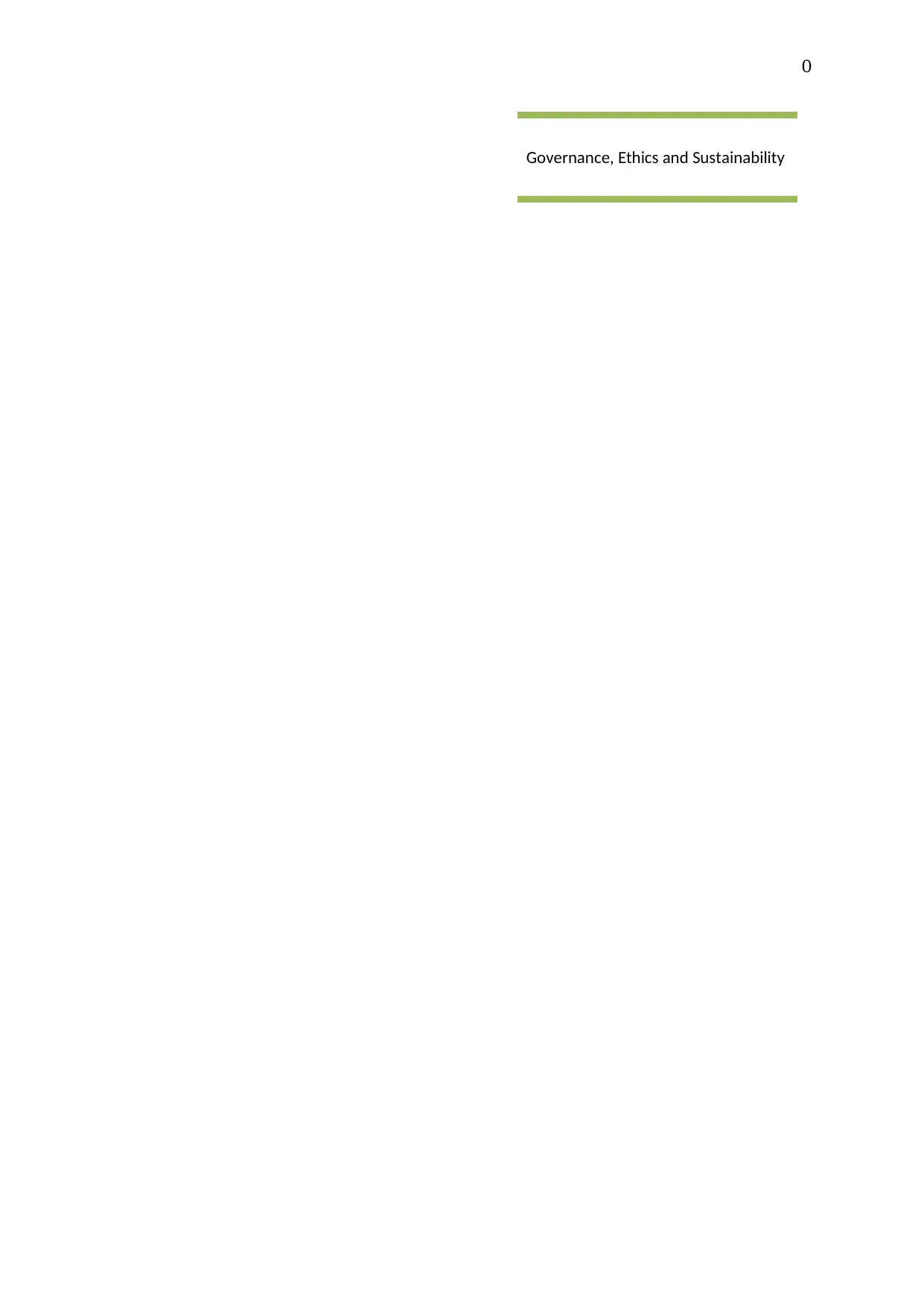
0
Governance, Ethics and Sustainability
Governance, Ethics and Sustainability
Paraphrase This Document
Need a fresh take? Get an instant paraphrase of this document with our AI Paraphraser
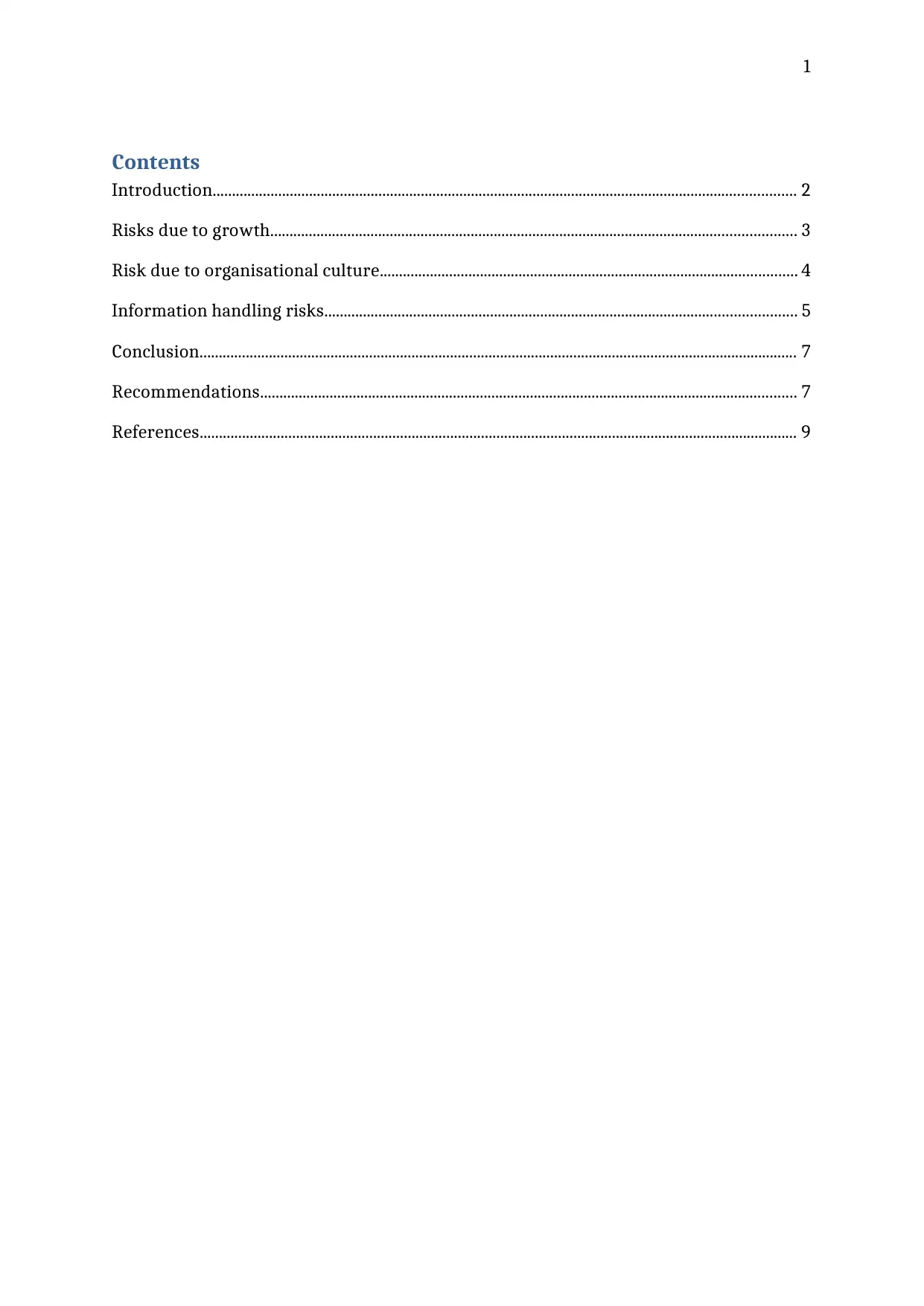
1
Contents
Introduction....................................................................................................................................................... 2
Risks due to growth........................................................................................................................................ 3
Risk due to organisational culture............................................................................................................ 4
Information handling risks.......................................................................................................................... 5
Conclusion........................................................................................................................................................... 7
Recommendations........................................................................................................................................... 7
References........................................................................................................................................................... 9
Contents
Introduction....................................................................................................................................................... 2
Risks due to growth........................................................................................................................................ 3
Risk due to organisational culture............................................................................................................ 4
Information handling risks.......................................................................................................................... 5
Conclusion........................................................................................................................................................... 7
Recommendations........................................................................................................................................... 7
References........................................................................................................................................................... 9
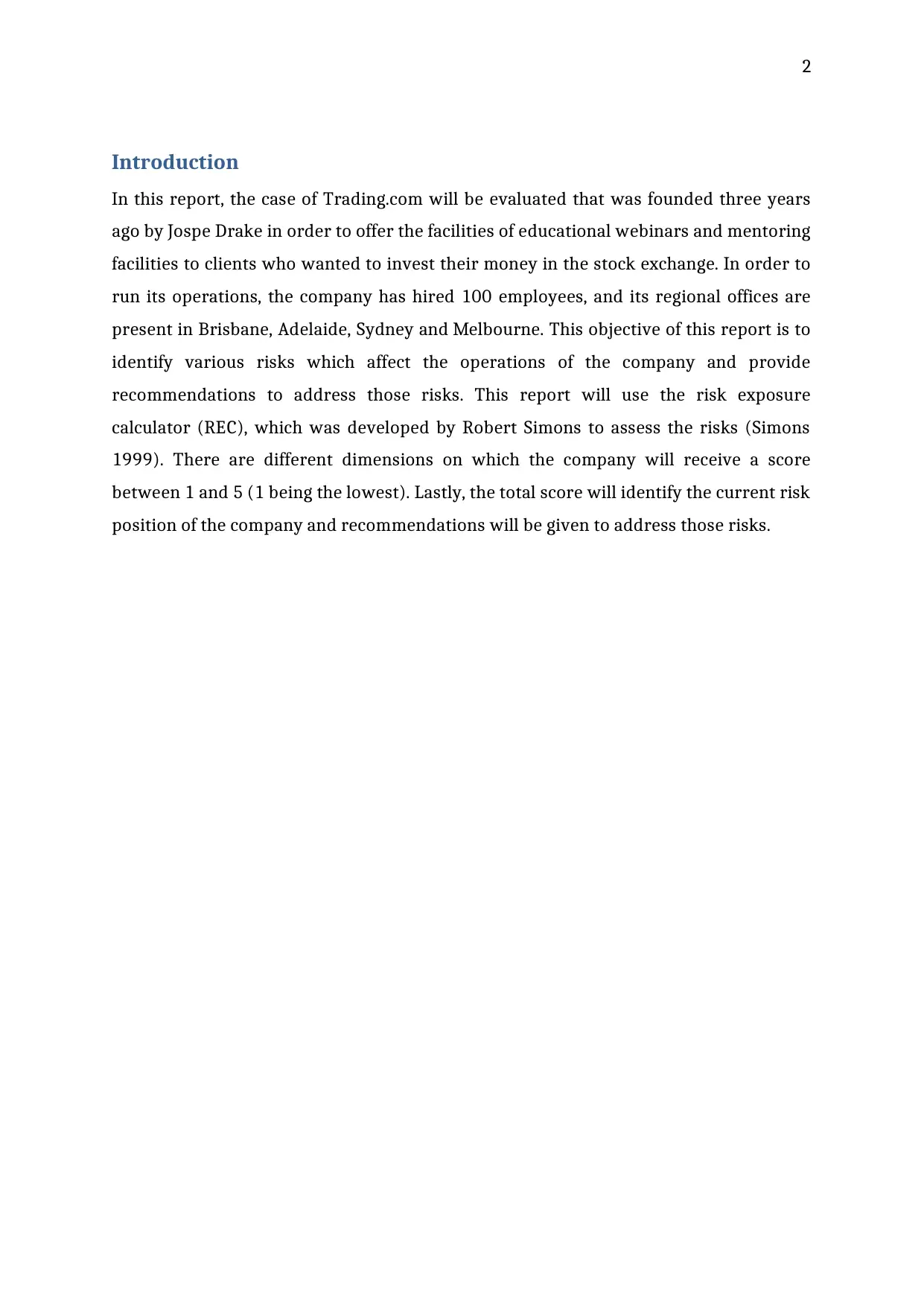
2
Introduction
In this report, the case of Trading.com will be evaluated that was founded three years
ago by Jospe Drake in order to offer the facilities of educational webinars and mentoring
facilities to clients who wanted to invest their money in the stock exchange. In order to
run its operations, the company has hired 100 employees, and its regional offices are
present in Brisbane, Adelaide, Sydney and Melbourne. This objective of this report is to
identify various risks which affect the operations of the company and provide
recommendations to address those risks. This report will use the risk exposure
calculator (REC), which was developed by Robert Simons to assess the risks (Simons
1999). There are different dimensions on which the company will receive a score
between 1 and 5 (1 being the lowest). Lastly, the total score will identify the current risk
position of the company and recommendations will be given to address those risks.
Introduction
In this report, the case of Trading.com will be evaluated that was founded three years
ago by Jospe Drake in order to offer the facilities of educational webinars and mentoring
facilities to clients who wanted to invest their money in the stock exchange. In order to
run its operations, the company has hired 100 employees, and its regional offices are
present in Brisbane, Adelaide, Sydney and Melbourne. This objective of this report is to
identify various risks which affect the operations of the company and provide
recommendations to address those risks. This report will use the risk exposure
calculator (REC), which was developed by Robert Simons to assess the risks (Simons
1999). There are different dimensions on which the company will receive a score
between 1 and 5 (1 being the lowest). Lastly, the total score will identify the current risk
position of the company and recommendations will be given to address those risks.
⊘ This is a preview!⊘
Do you want full access?
Subscribe today to unlock all pages.

Trusted by 1+ million students worldwide
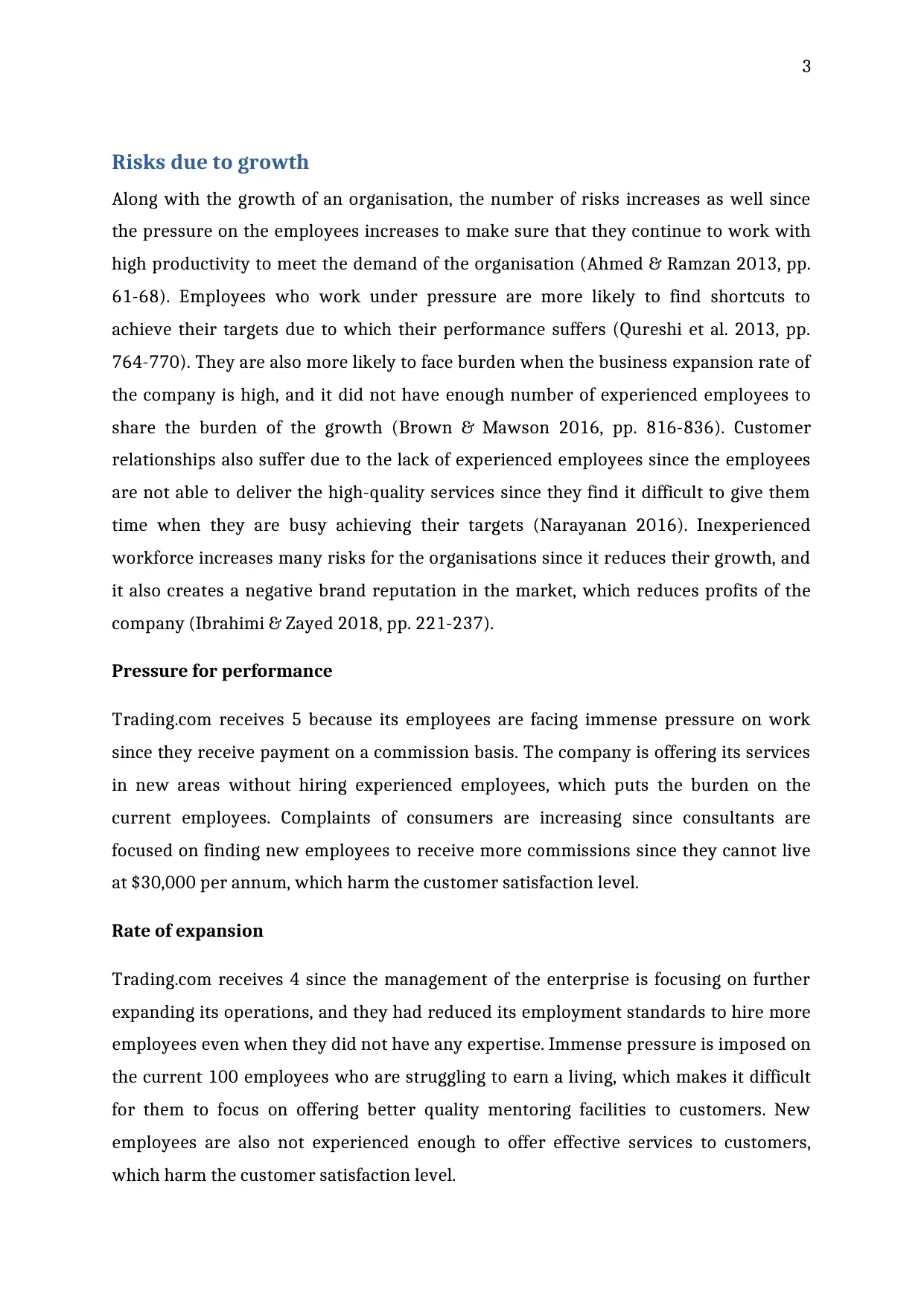
3
Risks due to growth
Along with the growth of an organisation, the number of risks increases as well since
the pressure on the employees increases to make sure that they continue to work with
high productivity to meet the demand of the organisation (Ahmed & Ramzan 2013, pp.
61-68). Employees who work under pressure are more likely to find shortcuts to
achieve their targets due to which their performance suffers (Qureshi et al. 2013, pp.
764-770). They are also more likely to face burden when the business expansion rate of
the company is high, and it did not have enough number of experienced employees to
share the burden of the growth (Brown & Mawson 2016, pp. 816-836). Customer
relationships also suffer due to the lack of experienced employees since the employees
are not able to deliver the high-quality services since they find it difficult to give them
time when they are busy achieving their targets (Narayanan 2016). Inexperienced
workforce increases many risks for the organisations since it reduces their growth, and
it also creates a negative brand reputation in the market, which reduces profits of the
company (Ibrahimi & Zayed 2018, pp. 221-237).
Pressure for performance
Trading.com receives 5 because its employees are facing immense pressure on work
since they receive payment on a commission basis. The company is offering its services
in new areas without hiring experienced employees, which puts the burden on the
current employees. Complaints of consumers are increasing since consultants are
focused on finding new employees to receive more commissions since they cannot live
at $30,000 per annum, which harm the customer satisfaction level.
Rate of expansion
Trading.com receives 4 since the management of the enterprise is focusing on further
expanding its operations, and they had reduced its employment standards to hire more
employees even when they did not have any expertise. Immense pressure is imposed on
the current 100 employees who are struggling to earn a living, which makes it difficult
for them to focus on offering better quality mentoring facilities to customers. New
employees are also not experienced enough to offer effective services to customers,
which harm the customer satisfaction level.
Risks due to growth
Along with the growth of an organisation, the number of risks increases as well since
the pressure on the employees increases to make sure that they continue to work with
high productivity to meet the demand of the organisation (Ahmed & Ramzan 2013, pp.
61-68). Employees who work under pressure are more likely to find shortcuts to
achieve their targets due to which their performance suffers (Qureshi et al. 2013, pp.
764-770). They are also more likely to face burden when the business expansion rate of
the company is high, and it did not have enough number of experienced employees to
share the burden of the growth (Brown & Mawson 2016, pp. 816-836). Customer
relationships also suffer due to the lack of experienced employees since the employees
are not able to deliver the high-quality services since they find it difficult to give them
time when they are busy achieving their targets (Narayanan 2016). Inexperienced
workforce increases many risks for the organisations since it reduces their growth, and
it also creates a negative brand reputation in the market, which reduces profits of the
company (Ibrahimi & Zayed 2018, pp. 221-237).
Pressure for performance
Trading.com receives 5 because its employees are facing immense pressure on work
since they receive payment on a commission basis. The company is offering its services
in new areas without hiring experienced employees, which puts the burden on the
current employees. Complaints of consumers are increasing since consultants are
focused on finding new employees to receive more commissions since they cannot live
at $30,000 per annum, which harm the customer satisfaction level.
Rate of expansion
Trading.com receives 4 since the management of the enterprise is focusing on further
expanding its operations, and they had reduced its employment standards to hire more
employees even when they did not have any expertise. Immense pressure is imposed on
the current 100 employees who are struggling to earn a living, which makes it difficult
for them to focus on offering better quality mentoring facilities to customers. New
employees are also not experienced enough to offer effective services to customers,
which harm the customer satisfaction level.
Paraphrase This Document
Need a fresh take? Get an instant paraphrase of this document with our AI Paraphraser
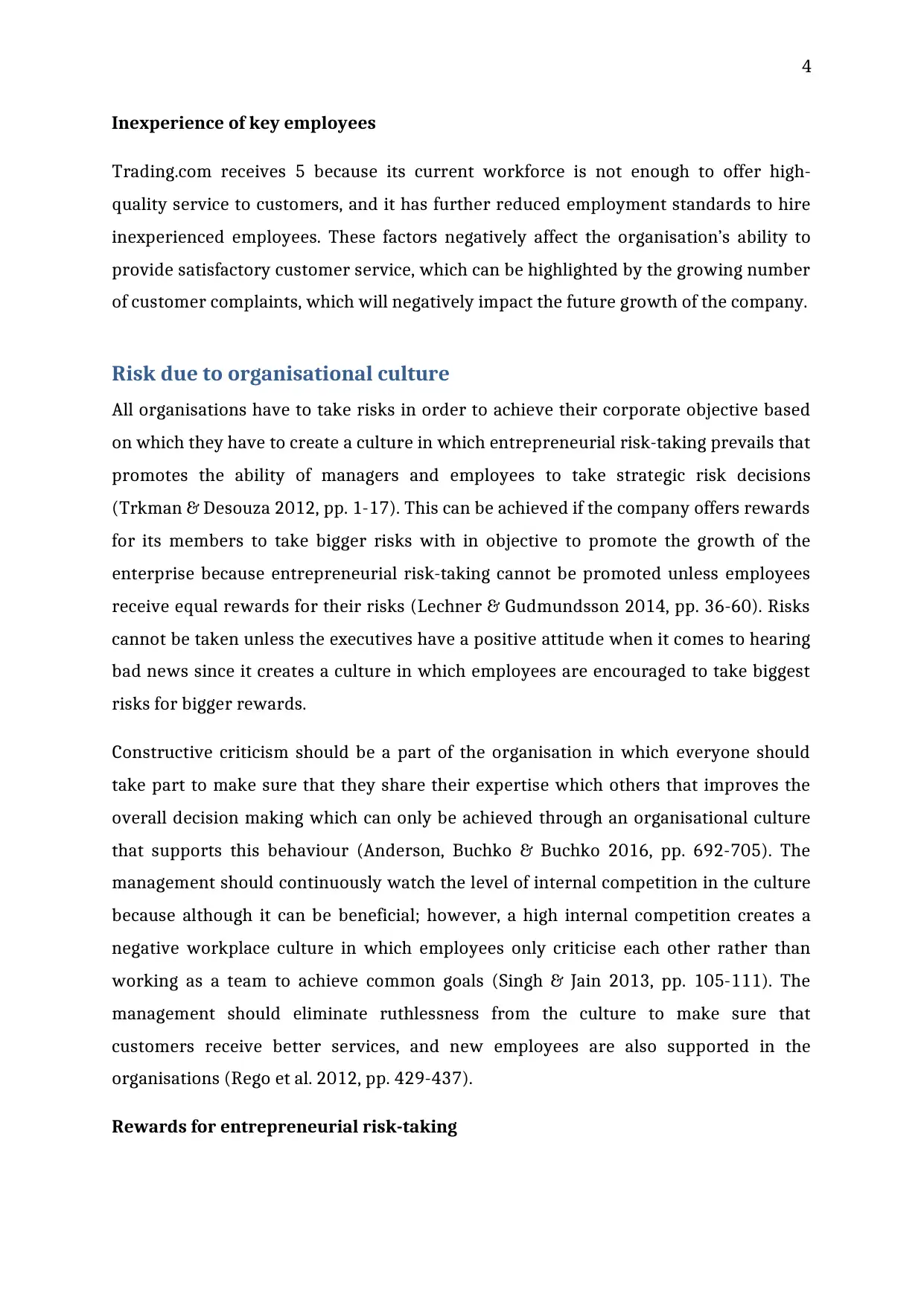
4
Inexperience of key employees
Trading.com receives 5 because its current workforce is not enough to offer high-
quality service to customers, and it has further reduced employment standards to hire
inexperienced employees. These factors negatively affect the organisation’s ability to
provide satisfactory customer service, which can be highlighted by the growing number
of customer complaints, which will negatively impact the future growth of the company.
Risk due to organisational culture
All organisations have to take risks in order to achieve their corporate objective based
on which they have to create a culture in which entrepreneurial risk-taking prevails that
promotes the ability of managers and employees to take strategic risk decisions
(Trkman & Desouza 2012, pp. 1-17). This can be achieved if the company offers rewards
for its members to take bigger risks with in objective to promote the growth of the
enterprise because entrepreneurial risk-taking cannot be promoted unless employees
receive equal rewards for their risks (Lechner & Gudmundsson 2014, pp. 36-60). Risks
cannot be taken unless the executives have a positive attitude when it comes to hearing
bad news since it creates a culture in which employees are encouraged to take biggest
risks for bigger rewards.
Constructive criticism should be a part of the organisation in which everyone should
take part to make sure that they share their expertise which others that improves the
overall decision making which can only be achieved through an organisational culture
that supports this behaviour (Anderson, Buchko & Buchko 2016, pp. 692-705). The
management should continuously watch the level of internal competition in the culture
because although it can be beneficial; however, a high internal competition creates a
negative workplace culture in which employees only criticise each other rather than
working as a team to achieve common goals (Singh & Jain 2013, pp. 105-111). The
management should eliminate ruthlessness from the culture to make sure that
customers receive better services, and new employees are also supported in the
organisations (Rego et al. 2012, pp. 429-437).
Rewards for entrepreneurial risk-taking
Inexperience of key employees
Trading.com receives 5 because its current workforce is not enough to offer high-
quality service to customers, and it has further reduced employment standards to hire
inexperienced employees. These factors negatively affect the organisation’s ability to
provide satisfactory customer service, which can be highlighted by the growing number
of customer complaints, which will negatively impact the future growth of the company.
Risk due to organisational culture
All organisations have to take risks in order to achieve their corporate objective based
on which they have to create a culture in which entrepreneurial risk-taking prevails that
promotes the ability of managers and employees to take strategic risk decisions
(Trkman & Desouza 2012, pp. 1-17). This can be achieved if the company offers rewards
for its members to take bigger risks with in objective to promote the growth of the
enterprise because entrepreneurial risk-taking cannot be promoted unless employees
receive equal rewards for their risks (Lechner & Gudmundsson 2014, pp. 36-60). Risks
cannot be taken unless the executives have a positive attitude when it comes to hearing
bad news since it creates a culture in which employees are encouraged to take biggest
risks for bigger rewards.
Constructive criticism should be a part of the organisation in which everyone should
take part to make sure that they share their expertise which others that improves the
overall decision making which can only be achieved through an organisational culture
that supports this behaviour (Anderson, Buchko & Buchko 2016, pp. 692-705). The
management should continuously watch the level of internal competition in the culture
because although it can be beneficial; however, a high internal competition creates a
negative workplace culture in which employees only criticise each other rather than
working as a team to achieve common goals (Singh & Jain 2013, pp. 105-111). The
management should eliminate ruthlessness from the culture to make sure that
customers receive better services, and new employees are also supported in the
organisations (Rego et al. 2012, pp. 429-437).
Rewards for entrepreneurial risk-taking
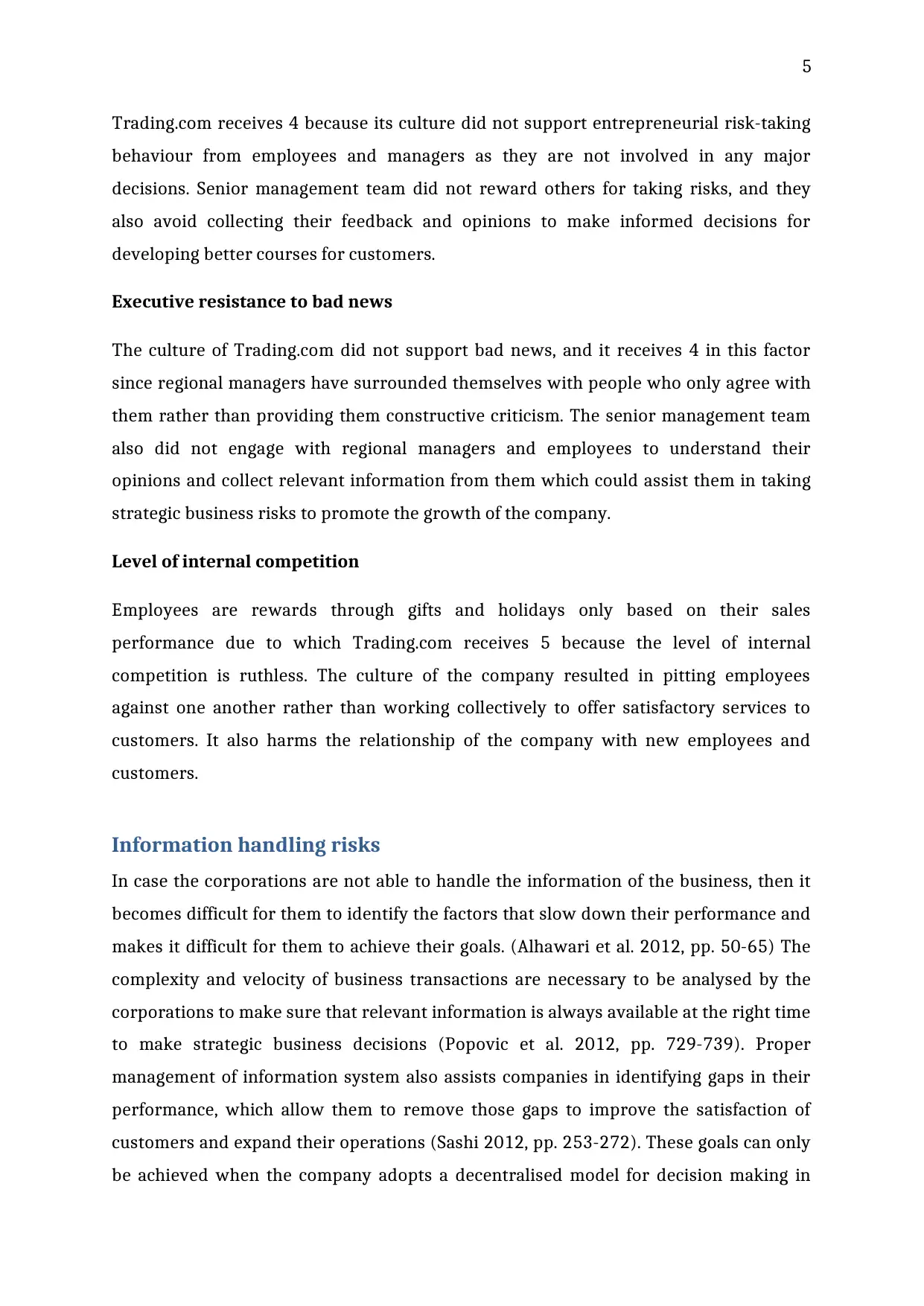
5
Trading.com receives 4 because its culture did not support entrepreneurial risk-taking
behaviour from employees and managers as they are not involved in any major
decisions. Senior management team did not reward others for taking risks, and they
also avoid collecting their feedback and opinions to make informed decisions for
developing better courses for customers.
Executive resistance to bad news
The culture of Trading.com did not support bad news, and it receives 4 in this factor
since regional managers have surrounded themselves with people who only agree with
them rather than providing them constructive criticism. The senior management team
also did not engage with regional managers and employees to understand their
opinions and collect relevant information from them which could assist them in taking
strategic business risks to promote the growth of the company.
Level of internal competition
Employees are rewards through gifts and holidays only based on their sales
performance due to which Trading.com receives 5 because the level of internal
competition is ruthless. The culture of the company resulted in pitting employees
against one another rather than working collectively to offer satisfactory services to
customers. It also harms the relationship of the company with new employees and
customers.
Information handling risks
In case the corporations are not able to handle the information of the business, then it
becomes difficult for them to identify the factors that slow down their performance and
makes it difficult for them to achieve their goals. (Alhawari et al. 2012, pp. 50-65) The
complexity and velocity of business transactions are necessary to be analysed by the
corporations to make sure that relevant information is always available at the right time
to make strategic business decisions (Popovic et al. 2012, pp. 729-739). Proper
management of information system also assists companies in identifying gaps in their
performance, which allow them to remove those gaps to improve the satisfaction of
customers and expand their operations (Sashi 2012, pp. 253-272). These goals can only
be achieved when the company adopts a decentralised model for decision making in
Trading.com receives 4 because its culture did not support entrepreneurial risk-taking
behaviour from employees and managers as they are not involved in any major
decisions. Senior management team did not reward others for taking risks, and they
also avoid collecting their feedback and opinions to make informed decisions for
developing better courses for customers.
Executive resistance to bad news
The culture of Trading.com did not support bad news, and it receives 4 in this factor
since regional managers have surrounded themselves with people who only agree with
them rather than providing them constructive criticism. The senior management team
also did not engage with regional managers and employees to understand their
opinions and collect relevant information from them which could assist them in taking
strategic business risks to promote the growth of the company.
Level of internal competition
Employees are rewards through gifts and holidays only based on their sales
performance due to which Trading.com receives 5 because the level of internal
competition is ruthless. The culture of the company resulted in pitting employees
against one another rather than working collectively to offer satisfactory services to
customers. It also harms the relationship of the company with new employees and
customers.
Information handling risks
In case the corporations are not able to handle the information of the business, then it
becomes difficult for them to identify the factors that slow down their performance and
makes it difficult for them to achieve their goals. (Alhawari et al. 2012, pp. 50-65) The
complexity and velocity of business transactions are necessary to be analysed by the
corporations to make sure that relevant information is always available at the right time
to make strategic business decisions (Popovic et al. 2012, pp. 729-739). Proper
management of information system also assists companies in identifying gaps in their
performance, which allow them to remove those gaps to improve the satisfaction of
customers and expand their operations (Sashi 2012, pp. 253-272). These goals can only
be achieved when the company adopts a decentralised model for decision making in
⊘ This is a preview!⊘
Do you want full access?
Subscribe today to unlock all pages.

Trusted by 1+ million students worldwide

6
which the power to make decisions is not exclusively limited to a few people. The
strategic decisions can only be made if relevant information about the market and
customers are collected from different levels of the organisation, and such information
is evaluated critically before making the decisions (Caker & Siverbo 2014, pp. 149-162).
Transaction complexity and velocity
Trading.com receives 3 in this factor since there are no policies adopted by the
enterprise that supports effective monitoring and reporting of transaction complexity
and velocity. The sales figures which are sent by the regional managers to the senior
management team are often delayed or not sent at all.
Gaps in diagnostic performance
There are no policies in Trading.com that identify gaps in its performance due to which
it receives 4. Consultants are not monitored by the regional managers who themselves
have no idea regarding the strategic goals of the management and the work of
employees, so they did not interfere in their operations. Sales figures are sent late or not
sent at all, and the senior management team did not consult with regional managers or
consultants while evaluating the information regarding the business.
Degree of decentralised decision making
The policies of Trading.com did not support decentralised decision making due to which
it receives 5. The power to make strategic decisions is only limited to a few people that
include Drake and the senior management team that did not collect information from
consultants or managers regarding the behaviour of customers and their problems.
Decisions are made solely on sales figures, and no other parties are involved in the
decision making.
which the power to make decisions is not exclusively limited to a few people. The
strategic decisions can only be made if relevant information about the market and
customers are collected from different levels of the organisation, and such information
is evaluated critically before making the decisions (Caker & Siverbo 2014, pp. 149-162).
Transaction complexity and velocity
Trading.com receives 3 in this factor since there are no policies adopted by the
enterprise that supports effective monitoring and reporting of transaction complexity
and velocity. The sales figures which are sent by the regional managers to the senior
management team are often delayed or not sent at all.
Gaps in diagnostic performance
There are no policies in Trading.com that identify gaps in its performance due to which
it receives 4. Consultants are not monitored by the regional managers who themselves
have no idea regarding the strategic goals of the management and the work of
employees, so they did not interfere in their operations. Sales figures are sent late or not
sent at all, and the senior management team did not consult with regional managers or
consultants while evaluating the information regarding the business.
Degree of decentralised decision making
The policies of Trading.com did not support decentralised decision making due to which
it receives 5. The power to make strategic decisions is only limited to a few people that
include Drake and the senior management team that did not collect information from
consultants or managers regarding the behaviour of customers and their problems.
Decisions are made solely on sales figures, and no other parties are involved in the
decision making.
Paraphrase This Document
Need a fresh take? Get an instant paraphrase of this document with our AI Paraphraser
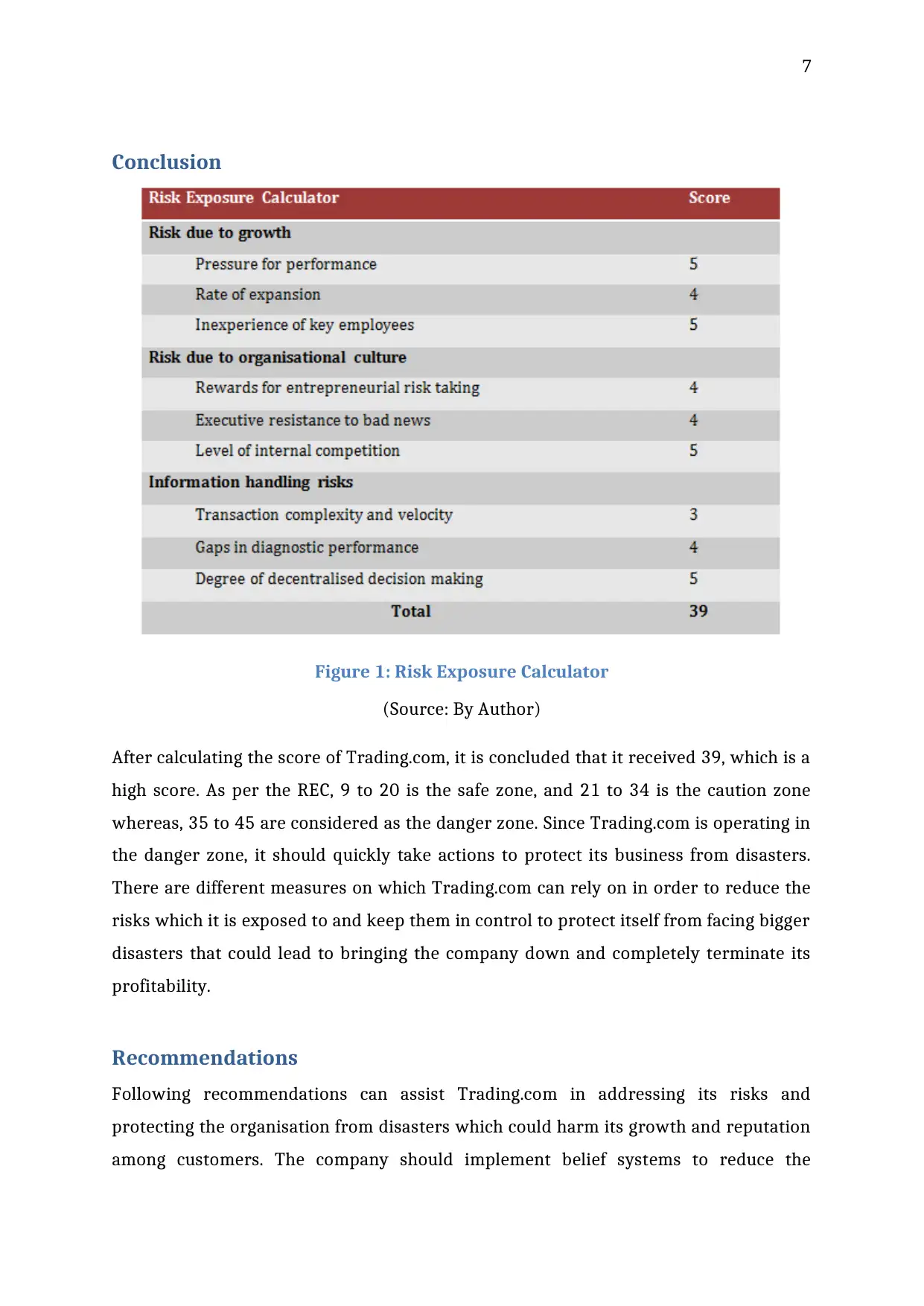
7
Conclusion
Figure 1: Risk Exposure Calculator
(Source: By Author)
After calculating the score of Trading.com, it is concluded that it received 39, which is a
high score. As per the REC, 9 to 20 is the safe zone, and 21 to 34 is the caution zone
whereas, 35 to 45 are considered as the danger zone. Since Trading.com is operating in
the danger zone, it should quickly take actions to protect its business from disasters.
There are different measures on which Trading.com can rely on in order to reduce the
risks which it is exposed to and keep them in control to protect itself from facing bigger
disasters that could lead to bringing the company down and completely terminate its
profitability.
Recommendations
Following recommendations can assist Trading.com in addressing its risks and
protecting the organisation from disasters which could harm its growth and reputation
among customers. The company should implement belief systems to reduce the
Conclusion
Figure 1: Risk Exposure Calculator
(Source: By Author)
After calculating the score of Trading.com, it is concluded that it received 39, which is a
high score. As per the REC, 9 to 20 is the safe zone, and 21 to 34 is the caution zone
whereas, 35 to 45 are considered as the danger zone. Since Trading.com is operating in
the danger zone, it should quickly take actions to protect its business from disasters.
There are different measures on which Trading.com can rely on in order to reduce the
risks which it is exposed to and keep them in control to protect itself from facing bigger
disasters that could lead to bringing the company down and completely terminate its
profitability.
Recommendations
Following recommendations can assist Trading.com in addressing its risks and
protecting the organisation from disasters which could harm its growth and reputation
among customers. The company should implement belief systems to reduce the
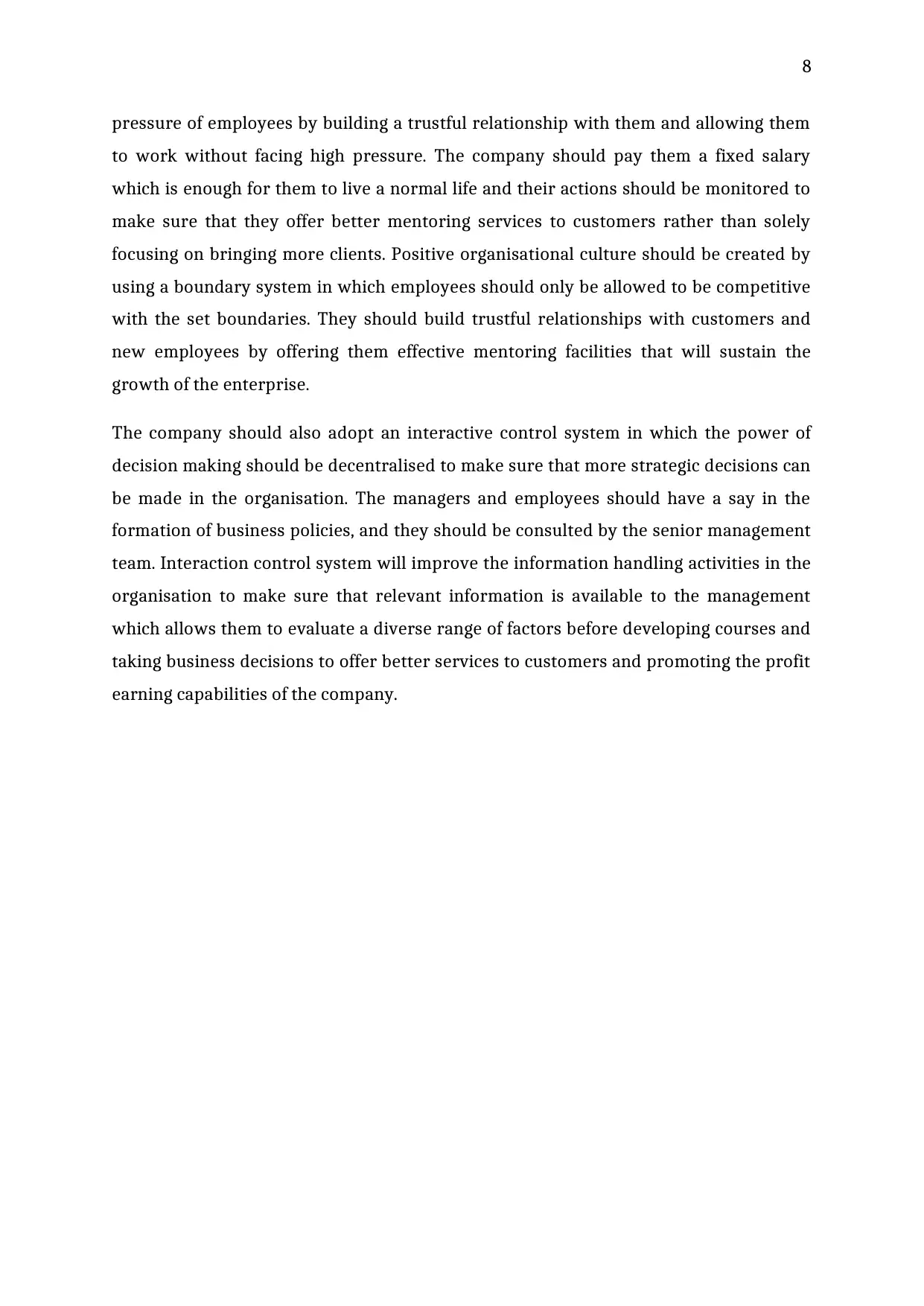
8
pressure of employees by building a trustful relationship with them and allowing them
to work without facing high pressure. The company should pay them a fixed salary
which is enough for them to live a normal life and their actions should be monitored to
make sure that they offer better mentoring services to customers rather than solely
focusing on bringing more clients. Positive organisational culture should be created by
using a boundary system in which employees should only be allowed to be competitive
with the set boundaries. They should build trustful relationships with customers and
new employees by offering them effective mentoring facilities that will sustain the
growth of the enterprise.
The company should also adopt an interactive control system in which the power of
decision making should be decentralised to make sure that more strategic decisions can
be made in the organisation. The managers and employees should have a say in the
formation of business policies, and they should be consulted by the senior management
team. Interaction control system will improve the information handling activities in the
organisation to make sure that relevant information is available to the management
which allows them to evaluate a diverse range of factors before developing courses and
taking business decisions to offer better services to customers and promoting the profit
earning capabilities of the company.
pressure of employees by building a trustful relationship with them and allowing them
to work without facing high pressure. The company should pay them a fixed salary
which is enough for them to live a normal life and their actions should be monitored to
make sure that they offer better mentoring services to customers rather than solely
focusing on bringing more clients. Positive organisational culture should be created by
using a boundary system in which employees should only be allowed to be competitive
with the set boundaries. They should build trustful relationships with customers and
new employees by offering them effective mentoring facilities that will sustain the
growth of the enterprise.
The company should also adopt an interactive control system in which the power of
decision making should be decentralised to make sure that more strategic decisions can
be made in the organisation. The managers and employees should have a say in the
formation of business policies, and they should be consulted by the senior management
team. Interaction control system will improve the information handling activities in the
organisation to make sure that relevant information is available to the management
which allows them to evaluate a diverse range of factors before developing courses and
taking business decisions to offer better services to customers and promoting the profit
earning capabilities of the company.
⊘ This is a preview!⊘
Do you want full access?
Subscribe today to unlock all pages.

Trusted by 1+ million students worldwide

9
References
Ahmed, A & Ramzan, M 2013, ‘Effects of job stress on employees job performance a
study on banking sector of Pakistan’, IOSR Journal of Business and Management, voll. 11,
no. 6, pp.61-68.
Alhawari, S, Karadsheh, L, Talet, AN & Mansour, E 2012, ‘Knowledge-based risk
management framework for information technology project’, International Journal of
Information Management, vol. 32, no. 1, pp.50-65.
Anderson, E, Buchko, AA & Buchko, KJ 2016, ‘Giving negative feedback to Millennials:
How can managers criticize the “most praised” generation’, Management Research
Review, vol. 39, no. 6, pp.692-705.
Brown, R & Mawson, S 2016, ‘Targeted support for high growth firms: Theoretical
constraints, unintended consequences and future policy challenges’, Environment and
Planning C: Government and Policy, vol. 34, no.5, pp.816-836.
Caker, M & Siverbo, S 2014, ‘Strategic alignment in decentralized organizations–The
case of Svenska Handelsbanken’, Scandinavian Journal of Management, vol. 30, no. 2,
pp.149-162.
Ibrahim, SN & Zayed, A 2018, ‘The Impact of the Integrated Talent Management on the
Competitive Advantage in Multinational Corporationst’, International Journal of
Academic Research in Business and Social Sciences, vol. 8, no. 7, pp.221-237.
Lechner, C & Gudmundsson, SV 2014, ‘Entrepreneurial orientation, firm strategy and
small firm performance’, International Small Business Journal, vol. 32, no. 1, pp.36-60.
Narayanan, A 2016, ‘Talent Management and Employee Retention: Implications of Job
Embeddedness-A Research Agenda’, Journal of Strategic Human Resource
Management, vol. 5, no. 2.
Popovic, A, Hackney, R, Coelho, PS & Jaklič, J 2012, ‘Towards business intelligence
systems success: Effects of maturity and culture on analytical decision making’, Decision
Support Systems, vol. 54, no. 1, pp.729-739.
References
Ahmed, A & Ramzan, M 2013, ‘Effects of job stress on employees job performance a
study on banking sector of Pakistan’, IOSR Journal of Business and Management, voll. 11,
no. 6, pp.61-68.
Alhawari, S, Karadsheh, L, Talet, AN & Mansour, E 2012, ‘Knowledge-based risk
management framework for information technology project’, International Journal of
Information Management, vol. 32, no. 1, pp.50-65.
Anderson, E, Buchko, AA & Buchko, KJ 2016, ‘Giving negative feedback to Millennials:
How can managers criticize the “most praised” generation’, Management Research
Review, vol. 39, no. 6, pp.692-705.
Brown, R & Mawson, S 2016, ‘Targeted support for high growth firms: Theoretical
constraints, unintended consequences and future policy challenges’, Environment and
Planning C: Government and Policy, vol. 34, no.5, pp.816-836.
Caker, M & Siverbo, S 2014, ‘Strategic alignment in decentralized organizations–The
case of Svenska Handelsbanken’, Scandinavian Journal of Management, vol. 30, no. 2,
pp.149-162.
Ibrahim, SN & Zayed, A 2018, ‘The Impact of the Integrated Talent Management on the
Competitive Advantage in Multinational Corporationst’, International Journal of
Academic Research in Business and Social Sciences, vol. 8, no. 7, pp.221-237.
Lechner, C & Gudmundsson, SV 2014, ‘Entrepreneurial orientation, firm strategy and
small firm performance’, International Small Business Journal, vol. 32, no. 1, pp.36-60.
Narayanan, A 2016, ‘Talent Management and Employee Retention: Implications of Job
Embeddedness-A Research Agenda’, Journal of Strategic Human Resource
Management, vol. 5, no. 2.
Popovic, A, Hackney, R, Coelho, PS & Jaklič, J 2012, ‘Towards business intelligence
systems success: Effects of maturity and culture on analytical decision making’, Decision
Support Systems, vol. 54, no. 1, pp.729-739.
Paraphrase This Document
Need a fresh take? Get an instant paraphrase of this document with our AI Paraphraser
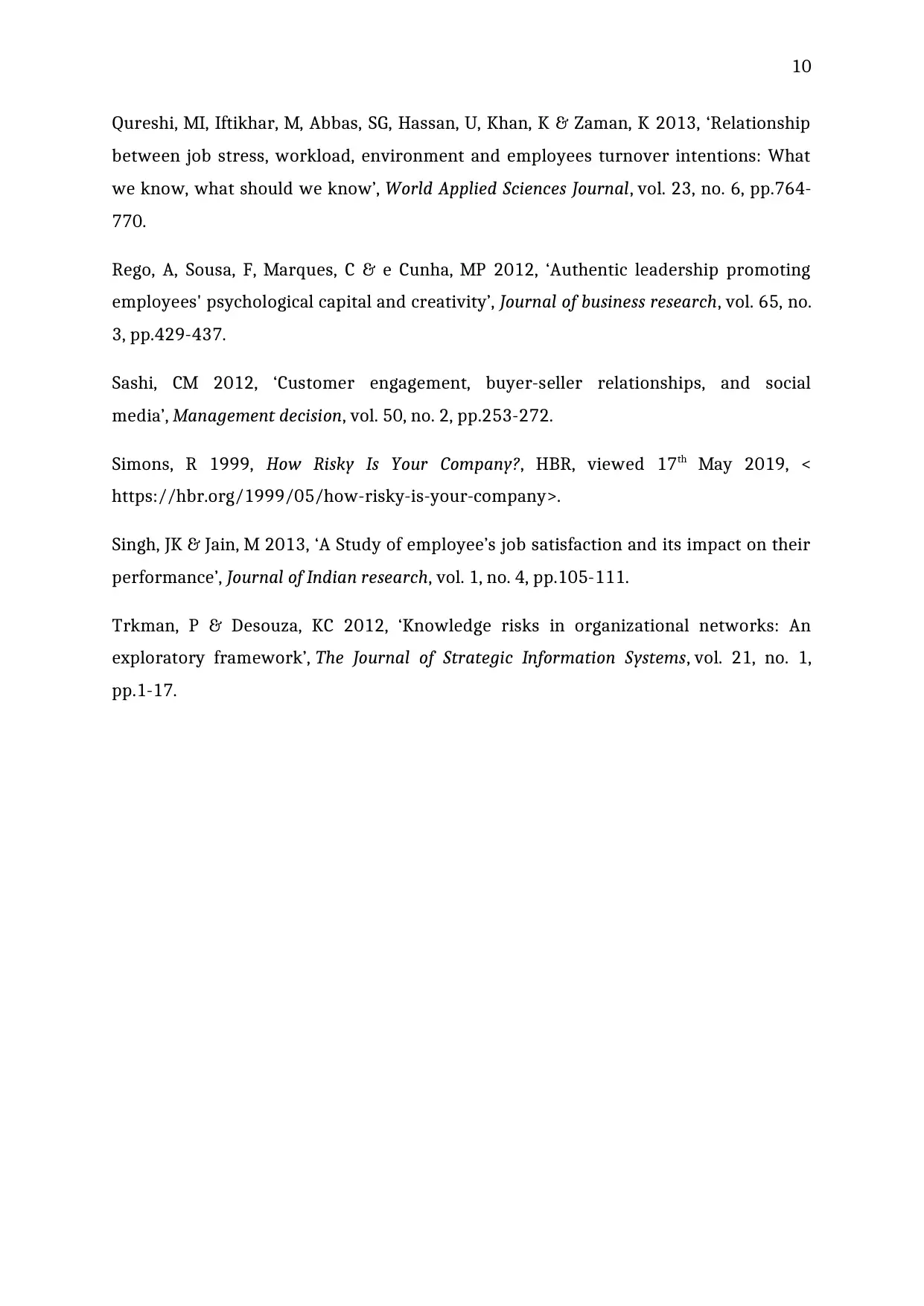
10
Qureshi, MI, Iftikhar, M, Abbas, SG, Hassan, U, Khan, K & Zaman, K 2013, ‘Relationship
between job stress, workload, environment and employees turnover intentions: What
we know, what should we know’, World Applied Sciences Journal, vol. 23, no. 6, pp.764-
770.
Rego, A, Sousa, F, Marques, C & e Cunha, MP 2012, ‘Authentic leadership promoting
employees' psychological capital and creativity’, Journal of business research, vol. 65, no.
3, pp.429-437.
Sashi, CM 2012, ‘Customer engagement, buyer-seller relationships, and social
media’, Management decision, vol. 50, no. 2, pp.253-272.
Simons, R 1999, How Risky Is Your Company?, HBR, viewed 17th May 2019, <
https://hbr.org/1999/05/how-risky-is-your-company>.
Singh, JK & Jain, M 2013, ‘A Study of employee’s job satisfaction and its impact on their
performance’, Journal of Indian research, vol. 1, no. 4, pp.105-111.
Trkman, P & Desouza, KC 2012, ‘Knowledge risks in organizational networks: An
exploratory framework’, The Journal of Strategic Information Systems, vol. 21, no. 1,
pp.1-17.
Qureshi, MI, Iftikhar, M, Abbas, SG, Hassan, U, Khan, K & Zaman, K 2013, ‘Relationship
between job stress, workload, environment and employees turnover intentions: What
we know, what should we know’, World Applied Sciences Journal, vol. 23, no. 6, pp.764-
770.
Rego, A, Sousa, F, Marques, C & e Cunha, MP 2012, ‘Authentic leadership promoting
employees' psychological capital and creativity’, Journal of business research, vol. 65, no.
3, pp.429-437.
Sashi, CM 2012, ‘Customer engagement, buyer-seller relationships, and social
media’, Management decision, vol. 50, no. 2, pp.253-272.
Simons, R 1999, How Risky Is Your Company?, HBR, viewed 17th May 2019, <
https://hbr.org/1999/05/how-risky-is-your-company>.
Singh, JK & Jain, M 2013, ‘A Study of employee’s job satisfaction and its impact on their
performance’, Journal of Indian research, vol. 1, no. 4, pp.105-111.
Trkman, P & Desouza, KC 2012, ‘Knowledge risks in organizational networks: An
exploratory framework’, The Journal of Strategic Information Systems, vol. 21, no. 1,
pp.1-17.
1 out of 11
Related Documents
Your All-in-One AI-Powered Toolkit for Academic Success.
+13062052269
info@desklib.com
Available 24*7 on WhatsApp / Email
![[object Object]](/_next/static/media/star-bottom.7253800d.svg)
Unlock your academic potential
Copyright © 2020–2025 A2Z Services. All Rights Reserved. Developed and managed by ZUCOL.





